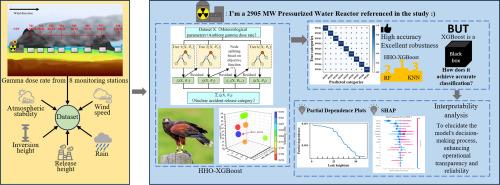核事故释放类别分类的可解释机器学习方法
IF 3.2
3区 工程技术
Q1 NUCLEAR SCIENCE & TECHNOLOGY
引用次数: 0
摘要
快速、可靠地识别事故类型对于指导对核事故的应急反应至关重要,特别是在现场仪器可能受损的情况下。本研究提出了一种基于2905 MW压水堆寿命末期非现场监测数据的事故分类方法,采用RADC放射性大气弥散模型生成模拟非现场数据,对WASH-1400规定的9个核电站事故释放类别(PWR1-9)进行分类。研究评估了KNN、RF和XGBoost的分类性能,其中XGBoost的准确率最高,达到99.58%。将Harris Hawks Optimization与XGBoost相结合,预测准确率提高到99.97%。为了确保实时决策支持的透明度和可信度,我们优先考虑了可解释性分析:部分依赖图和SHAP值揭示了伽马剂量率监测数据、风速和释放高度驱动模型预测。这些见解强调了保持这些关键参数的数据质量的重要性,并支持在核应急管理中将高性能分类与严格的可解释性相结合。本文章由计算机程序翻译,如有差异,请以英文原文为准。

An interpretable machine learning approach for classifying nuclear accident release categories
Rapid and reliable identification of accident types is essential for guiding emergency response to nuclear incidents, especially when on-site instrumentation may be compromised. This study proposes an accident classification approach based on off-site monitoring data for a 2905 MW pressurized water reactor at end-of-life, employing the RADC radioactive atmospheric dispersion model to generate simulated off-site data for categorizing nine nuclear power plant accident release categories (PWR1-9) specified in the WASH-1400. The research evaluated classification performance of KNN, RF, and XGBoost, with XGBoost achieving the highest accuracy of 99.58 %. By integrating Harris Hawks Optimization with XGBoost, prediction accuracy was enhanced to 99.97 %. To ensure transparency and trust in real-time decision support, we prioritized interpretability analysis: Partial Dependence Plot and SHAP value reveal that gamma dose rate monitoring data, wind speed and release height drive model predictions. These insights highlight the importance of maintaining data quality for these key parameters and support the integration of high-performance classification with rigorous interpretability in nuclear emergency management.
求助全文
通过发布文献求助,成功后即可免费获取论文全文。
去求助
来源期刊

Progress in Nuclear Energy
工程技术-核科学技术
CiteScore
5.30
自引率
14.80%
发文量
331
审稿时长
3.5 months
期刊介绍:
Progress in Nuclear Energy is an international review journal covering all aspects of nuclear science and engineering. In keeping with the maturity of nuclear power, articles on safety, siting and environmental problems are encouraged, as are those associated with economics and fuel management. However, basic physics and engineering will remain an important aspect of the editorial policy. Articles published are either of a review nature or present new material in more depth. They are aimed at researchers and technically-oriented managers working in the nuclear energy field.
Please note the following:
1) PNE seeks high quality research papers which are medium to long in length. Short research papers should be submitted to the journal Annals in Nuclear Energy.
2) PNE reserves the right to reject papers which are based solely on routine application of computer codes used to produce reactor designs or explain existing reactor phenomena. Such papers, although worthy, are best left as laboratory reports whereas Progress in Nuclear Energy seeks papers of originality, which are archival in nature, in the fields of mathematical and experimental nuclear technology, including fission, fusion (blanket physics, radiation damage), safety, materials aspects, economics, etc.
3) Review papers, which may occasionally be invited, are particularly sought by the journal in these fields.
 求助内容:
求助内容: 应助结果提醒方式:
应助结果提醒方式:


